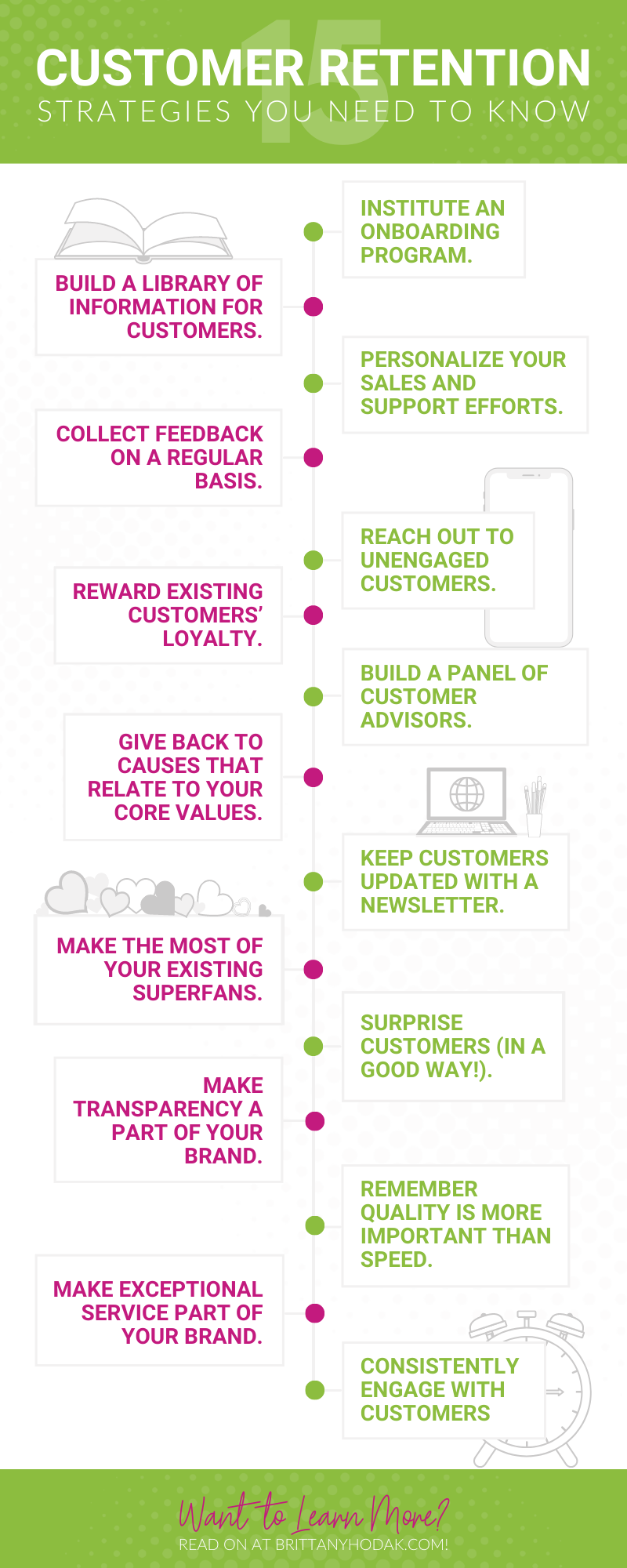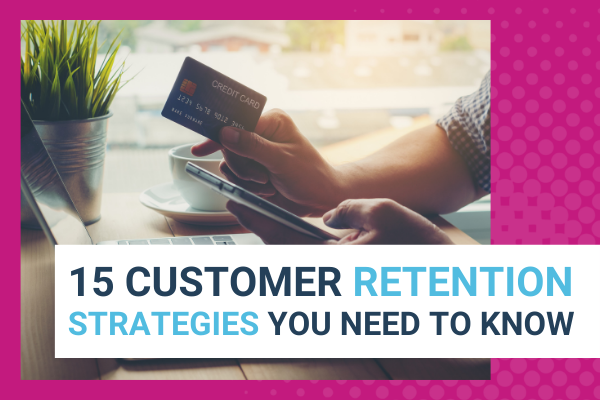You know how to attract new customers, but how do you keep them engaged with your business? If you want to grow a sustainable, customer-first business, you need to focus on the right customer retention strategies. Customers who continue coming back to your business time and time again are the most important asset you have.
Unfortunately, too many businesses today focus on growing their customer base instead of improving the experience for current customers or clients. This is a short-term approach with the potential for long-term fallout. A reported 50% of loyal customers have left a company for a competitor who was better at meeting their needs.
However, as you’ll quickly learn, it’s not always easy to keep customers coming back. How do you stay competitive in a world that’s always changing? The good news is that if you’ve already convinced a customer to convert once, you’ve already done much of the heavy lifting.
What’s next is to implement the right customer retention strategies to turn these passive customers into real-life superfans. Here are the 15 customer retention strategies you need to build a future-proof business.
Institute an onboarding program.
First, you need a clear onboarding program. What does this mean? It’s simple: customers are more likely to stick around if you make it easy for them to either use your product/service, share information about your team, and clarify why your brand is better than the rest. Because it’s 5 to 25 more expensive to acquire a new customer than keep a current one, your onboarding program has a huge effect.
Not only does customer onboarding give your newest customers a warm welcome, but it builds strong relationships. We all understand the frustration of getting a new product or trying a new service or software only to encounter questions and concerns along the way. Ease this tension through onboarding.
Build a library of information for customers.
Next, give your customers the support and guidance necessary to solve problems on their own terms. While a strong support team is always a must, customers don’t usually want to contact support unless they have to. By building a library of information, your customers can solve low-level concerns quickly and efficiently.
A brand that does a great job with this is Apple. Their support tools are easy to navigate, and customers can find walk-through help for common problems, concerns, and tech issues. This tech giant is definitely on the right track considering that of all self-service channels, customers make the most frequent use of knowledge bases.
Personalize your sales and support efforts.
Additionally, customers don’t want to feel like just a number on a support ticket. They want to feel heard, understood, and valued. This is one of the biggest pieces of the customer experience puzzle. When you customize emails, phone calls, support tickets, and so on with your customer’s name and specific support history, you show that you see them as an individual.
Because this can be a lot to manage, using a CRM tool is a huge help. By tracking customers’ experiences with your company, past support needs, and so on, you transform a typical customer service interaction into an opportunity to make a new superfan. A reported 56% of customers don’t mind sharing personal information if it means they get better service in return, so don’t be afraid to leverage customer data in a meaningful way.
Collect feedback on a regular basis.
If you’re not collecting customer feedback, you’re operating your brand in a vacuum. In reality, customer feedback is your greatest source for ideas, improvements, and so on. If you don’t know what your customers like (and better yet, what they don’t), how can you ever expect to do better?
With over half of all consumers expecting companies to take action on feedback, don’t take these responses for granted. When brands proactively invite and accept customer feedback, they’re seen 77% more favorably.
Reach out to unengaged customers.
Another way many brands lose customers is by failing to re-engage when a customer begins to lose interest. Just because a customer hasn’t made a purchase in a while doesn’t mean they aren’t likely to do so in the future, but they do need more nurturing.
Instead of letting them go their own separate way, show them you’re invested in them and their customer loyalty. Continue building a strong relationship by sharing new deals, offers, and content that gives them real value.
For example, the beauty retailer Ulta does a great job re-engaging past customers by offering special deals and loyalty points via email. Because these offers are time-sensitive, users are likely to act quickly (and purchase more products).
Reward existing customers’ loyalty.
If your best friend was staying with a partner that didn’t appreciate them, you wouldn’t want them to stay with this person. The same is true for brands. It’s all about appreciation and feeling valued. Feeling unappreciated is the top reason customers switch from specific products and services.
How can you reward your existing customers for staying loyal to your brand? It doesn’t have to be complicated, and you don’t have to reinvent the wheel. Here are some great ideas:
- Create a loyalty program
- Offer discount for high-spending customers
- Give away free items with multiple purchases
- Invite existing customers to events in-store or online
- Reward customers for referrals
Build a panel of customer advisors.
While you should ask for feedback from all customers, it’s worth investing in a panel of customer “advisors.” These are your most active and engaged customers who want to see you grow. Because they’re already closely engaging with your brand, they are likely your best source of information on your current performance.
Whenever you’re working on a new product or service, utilize this panel of customer advisors. Ask for feedback, ideas, and criticism. These real-world responses are sure to help you grow before you launch something to a wider group.
Give back to causes that relate to your core values.
Next, we live in an era of social change. People want to do good with their money. In fact, instead of donating money directly to causes they care about, most shoppers under 40 actually prefer to give back where they shop. Not only does this give brands an opportunity to do good, but you can also connect with your core values on a deeper level.
The most successful brands of today know the importance of giving back. To see what we mean, look at Lola, a feminine health and hygiene brand. Lola makes it clear that when you make a purchase through them, you support women’s health and wellness programs across the nation. By partnering with the nonprofit I Support the Girls, Lola has donated over 5 million feminine hygiene products. This helps them stand out in the best way against the competition.
Keep customers updated with a newsletter.
Another way to keep existing customers engaged is with a newsletter. Email newsletters are a powerful tool that many modern brands leave on the backburner. Newsletters engage customers while sharing company updates. Engaged, returning customers have the potential to boost revenue by up to 23% over time.
When customers are excited about new releases, products, and updates, they’ll stick around. A newsletter is an important part of building a strong, long-term relationship with your best customers. Planoly, a social media scheduling app, does a fantastic job of engaging existing customers with their newsletter. By sharing their latest expert tips and guides, they not only give their users additional value, but they also create strong relationships.
Make the most of your existing superfans.
Let’s face it: customers trust other customers, friends, and family much more than they trust you as a brand. Sharing reviews, testimonials, and praise from your best customers (aka your superfans) is a powerful way to influence your existing audience.
The proof is in the research. With 90% of customers saying they’re influenced by positive reviews when buying a product, it’s clear you can’t ignore the power of sharing testimonials. This is how you “show” how great you are without “telling.” You can talk about how amazing your products are all day long, but they’ll never come close to customer reviews.
Surprise customers (in a good way!).
How do you go above and beyond to show customers they’re appreciated and valued? Surprises are a great way to treat your current customers, especially if they haven’t engaged with your brand in a while. Who doesn’t love a special discount, freebie, or add-on?
A single positive experience with a company pays off. After a positive experience, 77% of customers would recommend it to a friend. The fast-food giant McDonalds does a fabulous job of surprising existing customers who use their mobile app. With surprise in-app deals and exclusive offers, it’s easy to see why McDonad’s brand value is over 129 billion.
Make transparency a part of your brand.
Next, make transparency a foundational part of your brand. In business, transparency is when a brand maintains honest, open, and accessible communications about business operations, goals, value, and data. In other words, your customers appreciate honesty. Even if you make a mistake, staying transparent and owning up to it does wonders for your brand image.
A lot of brands are understandably afraid to pull back the curtain on their mistakes. In reality, there’s no reason to worry. A reported 70% of unhappy customers who have their problems resolved are willing to shop with a business again. Knowing how to own up to a mistake, avoid the blame game, and use it as an opportunity for growth is a powerful skill.
Quality is more important than speed.
If you’re not going to do something right, why bother doing it at all? If you deliver a bad experience, it doesn’t matter how “fast” it was. Taking the time to make your customer feel like you value them is always worthwhile.
While it might make sense to deliver a fast answer vs. the perfectly “correct” answer, this is bad news for your brand. Today, 44% of customers say they’ve received a wrong answer from a customer service representative in the past. This is a turn-off, and it pushes your customers towards the competition.
Make exceptional service part of your brand.
Additionally, not only does exceptional customer service retain your current customers, but it also increases your referrals. Businesses that deliver better customer experiences overall earn between 4% and 8% higher revenue in their market.
The outdoor CO-OP REI is a shining example of a brand that focuses on customer service every step of the way. With a 100% satisfaction guaranteed, live chat, phone support, social media representatives, and an online help center, it’s easy to see how REI includes support in every aspect of their brand identity.
Consistently engage with customers, in-person and/or online.
Lastly, the final customer retention strategy is to always engage with customers both in-person and online. Your customers are your biggest asset. The more you talk with them directly, the more you understand their feedback and see things from their perspective.
Whether you’re engaging with your community on social media, through emails, or in stores, these are the relationships long-term brands are built on. Customer service isn’t limited to any specific team. It’s a company-wide effort, and it’s a part of creating a brand your customers are passionate about supporting.
Keep Your Customers Coming Back
Whether you’re just getting started or you’ve been in business for a while, it’s not enough to focus on attracting new customers. While this is an important part of the overall puzzle, it’s not the full story. It’s always cheaper to keep your existing customers coming back than it is to constantly source new ones.
How are you showing your existing customers that they’re valued and supported? If you’re not sure, these customer retention strategies above aren’t optional. They’re a path forward towards a secure, stable future for your brand built on customer loyalty.

